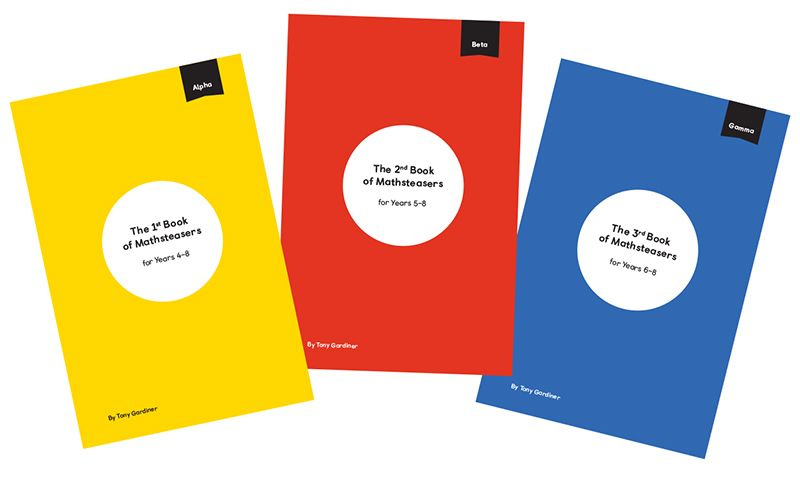The Mathsteasers How-To Guide

Mathsteasers are a series of booklets that give advanced learners and adventurous pupils a conceptual stretch and added challenge. Designed to be flexible, you can introduce and use Mathsteasers however you see fit.
To help you get started, we’ve outlined some key ways you can use Mathsteasers in your class. While this page covers a wide range of techniques, it’s by no means definitive: members of our community are always finding new ways to use Mathsteasers.
One more thing: keep an eye on this page! We’re constantly adding new best practices and ways to use Mathsteasers from the Maths — No Problem! community.
Mathsteasers span three booklets: Alpha, Beta and Gamma. Here’s what they offer:
Alpha
Based on the Year 4 national curriculum, Alpha consists of 12 chapters and 143 questions in total. Topics include Place Value, Time and Roman Numerals.
Beta
Based on the Year 5 national curriculum, Beta consists of 13 chapters and 158 questions in total. Topics include Fractions, Decimals and Geometry.
Gamma
Based on the Year 6 national curriculum, Gamma consists of 12 chapters and 199 questions in total. Topics include Word Problems, Ratio and Pre-algebra.
How to use Mathsteasers
While Mathsteasers are designed to be flexible, there are some best practices to keep in mind. We’ve also listed below a few techniques that teachers in the MNP community have found useful.
Have a suggestion of your own? We’d love to hear it! Email us — we welcome ideas and updates from educators like you.
Give them a try
It’s key to attempt some of the problems before introducing them to pupils. This lets you assess the difficulty of the problem, and better understand the question’s objective. Remember: these questions can be very difficult even for adults, so don’t worry if you can’t answer them right away!
Create the right atmosphere
It’s important to create an atmosphere where pupils know extra challenges are available. All children will struggle with different areas of learning. When it comes to that struggle, all pupils — including advanced learners — should feel supported. Work to create a classroom culture where struggle is promoted and celebrated, and not discouraged.
Choose carefully
You know your class better than anyone: where they struggle, and where they shine. Use that knowledge to carefully select Mathsteasers questions that give your pupils the challenge that’s right for them.
When choosing questions, think about the objective of your lesson, and how you can provide that conceptual stretch.
To help pick the right question, each problem is ranked with a star system:
No stars = an average Mathsteasers question
One star = more difficult than average
Two stars = very difficult
Feeling stuck on a problem? Solutions, full explanations and additional guidance are at the end of each chapter.
Let them navigate
Encourage learners to find the Mathsteasers booklet for themselves. Go one step further and ask them to find the question. It’s a simple step, but an important one that can foster independent learning and resilience.
Put it up on the board
Write your Mathsteasers question on the board before or during a lesson. You can nudge advanced learners towards the problem, but don’t discourage other learners: it’s perfectly okay if adventurous pupils struggle or fail.
If the majority of your class don’t get to the question, don’t worry. Mathsteasers should not be the objective of a lesson — standard content is enough of a challenge for most.
Use questions as an Anchor Task
If a Mathsteasers question fits your lesson objective for the day, you can use it as an anchor task. Give your class time to tackle the question in pairs or groups. While pupils may find the question too difficult to tackle individually, working in groups gives learners the opportunity to discuss the question, analyse the problem and hopefully reach a solution.
Work through it
Advanced learners can work through a Mathsteasers chapter to see how far they get. When they reach a tough spot, encourage them to power through it rather than giving up. This promotes resilience and positive attitudes about success and struggle — essential skills for every learner.
Use it to refresh
Mathsteasers help gauge pupils’ retention skills. Use a problem that relates to content from a previous lesson or topic, and ask learners if there’s something they’ve already learnt that could help solve the problem. If they struggle to connect the problem to prior lessons, this could indicate that the pupil hasn’t understood the topic at a greater depth.
Support homework
Learners may feel more comfortable struggling and experimenting with challenging questions while attempting problems at home. If you do provide a Mathsteasers question as a homework exercise, choose a question that builds on concepts taught in that day’s lesson.
Pair with Journaling
Mathsteasers pair well with journaling. Even if a pupil finds a question too difficult, ask them to write down their thinking around it. This lets you see their starting point, the methods they used to attempt the problem and any links they’ve made between prior concepts. You’ll gain a clear view of how they understood the problem, and the steps needed to deepen their understanding of a concept.

Join the Mathsteasers community!
From best practices to teaching techniques, tell us how you use Mathsteasers. We’re always adding the latest Mathsteasers tips and techniques from educators like you to to this page. Be sure to check back soon!
Email UsPossible pupil reactions
The goal of Mathsteasers is to inspire pupils to extend their learning, and to embrace struggle as a positive element of learning. But every learner will respond to Mathsteasers differently. Here are some ways we’ve seen learners respond to Mathsteasers.
The Eager Beaver
Eager beavers rush to attempt questions. While enthusiasm for maths is always appreciated, you may need to encourage these pupils to slow down and reassess their understanding of the topic if they are struggling.
The Coaster
Coasters are very confident with core material, and have likely been able to cruise through lessons up until now. Many will welcome the extra challenge, so be sure to encourage and help sustain that enthusiasm.
The High Achiever
High achievers may not appreciate Mathsteasers at first. They’ll face complex questions that require deep analysis — a challenge for pupils who rely on strong arithmetic skills. Encourage them to think about their prior knowledge and how it applies to complex multi-step problems.
Ongoing support
Everyone benefits from a challenge, but throwing your pupils straight into the deep end isn’t an effective approach. Try to find a balance between fostering resilience and leaving pupils to fend for themselves. Pupils should never feel alone. They need to feel supported as they get to grips with this new challenge.
Before jumping in, encourage them to find support from their peers. Peer to peer learning builds pupils’ maths confidence, and promotes active learning and collaboration.
When pupils hit a wall, ask them to take a step back and look at the problem line by line. This makes sure they’ve read the question thoroughly. Encourage them to self assess at each line: what else do I know? What else can I learn? What else can I interpret?
If they resist a question, ask for feedback. Let them verbalise what they’re struggling with.
If you’re surprised a pupil is struggling with a question, it’s possible they’re overwhelmed with the number of parts to it. See if giving them one example, rather than 10, lets them focus their attention therefore having more success with the problem.
One last thing
Supporting pupils of all attainment levels is crucial to lasting maths success. We hope Mathsteasers promotes the productive struggle all learners can benefit from.
Remember: keep your eyes peeled on this page! We’re always adding experiences, tips and techniques from educators like you.